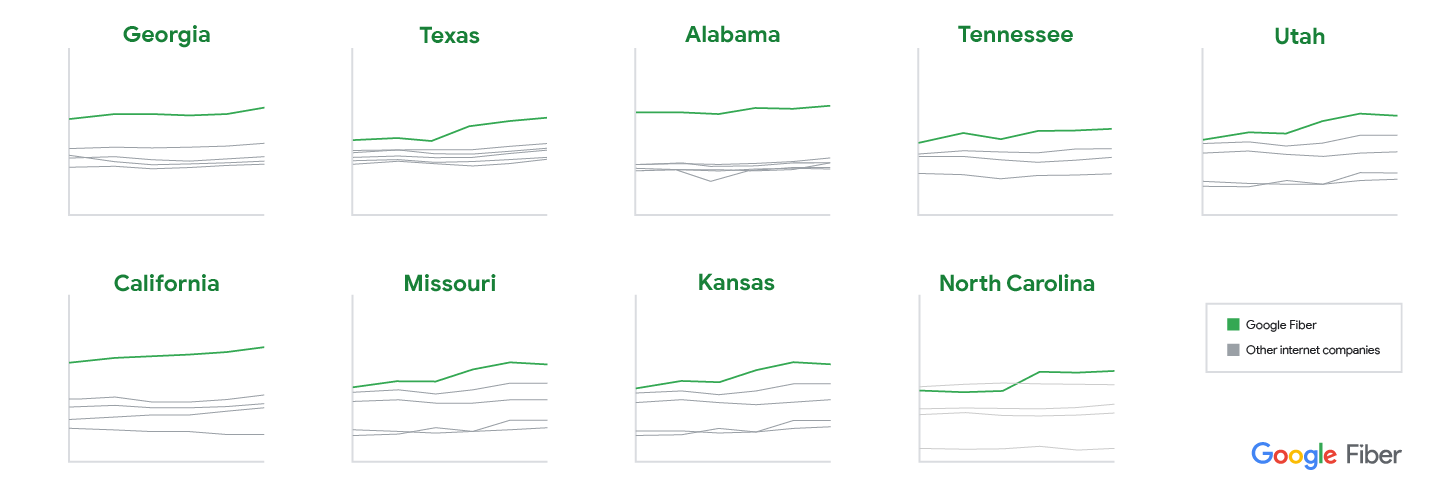April 29, 2021
Building a network to handle any load
Ookla recently released its Q1 2021 data for internet speeds, and we're happy to see that Google Fiber tops that list in all of our cities across the country. We're slowing down for a moment to look at how we got here by looking back at what 2020’s challenges meant for our customers and how we helped meet the increased demand for internet as everyone moved their world online — school, work, connecting with family and friends, streaming, gaming, shopping, and so much more.
The demand for internet has never been greater. At Google Fiber, we saw about a 32% uptick in demand across our network in all our cities throughout the pandemic. While our network is definitely built to handle this, we wanted to make sure that our customers never feel the squeeze.
To handle the additional traffic, not just for now, but the future as well, especially as we have more customers opting for 2 Gig as it rolls out across the country, we took several actions over the last year to improve both network capacity and resiliency. That’s why our internet was able to meet the increased demand for bandwidth, and we were able to reduce latency (the time it takes for your internet to load) for our customers as well.
Internet speeds from January to June 2020*

Increasing Capacity
In 2020, we increased capacity at every point in our network, from support facilities right into our customers’ homes. By working to increase throughput across our network, we’re ensuring that you have the fastest internet coming into your house.
But we all know that’s only as good as your Wi-Fi, since most internet usage in our homes is over Wi-Fi rather than wired ethernet. So we worked to improve Wi-Fi performance for Google Fiber customers, launching use your own router as an option for customers who know what they want and incorporating Google Wifi devices to provide more options for customers to adapt their Wi-Fi coverage to the layout and needs of their homes.
Improving Resiliency
Availability and resiliency is about making it easier to get where you are going on the internet. As demand for teleconferencing services and online learning platforms soared, Google Fiber worked with such providers to optimize network traffic to ensure our customers don’t experience glitchy meetings or disrupted student lessons regardless of how many people are learning or working on the network. And that wasn’t just true for work —as demand for streaming video for news and entertainment and online gaming rose, we also made sure that content came through without buffering or lag.
All this backend work was designed so that our customers just didn’t have to think about their internet connection. The goal was to make internet one less thing for customers to have to think about — especially this past year when we all had plenty to take up brain space.
We’re continuing to look at new ways to improve our network and meet what’s coming next in 2021 and beyond. Internet demand is only going to increase as we can do more and more online, and Google Fiber will be ready to help you make that journey.
Posted by Terrill Gosa, Senior Director, Engineering & Operations

The demand for internet has never been greater. At Google Fiber, we saw about a 32% uptick in demand across our network in all our cities throughout the pandemic. While our network is definitely built to handle this, we wanted to make sure that our customers never feel the squeeze.
To handle the additional traffic, not just for now, but the future as well, especially as we have more customers opting for 2 Gig as it rolls out across the country, we took several actions over the last year to improve both network capacity and resiliency. That’s why our internet was able to meet the increased demand for bandwidth, and we were able to reduce latency (the time it takes for your internet to load) for our customers as well.
Internet speeds from January to June 2020*
Increasing Capacity
In 2020, we increased capacity at every point in our network, from support facilities right into our customers’ homes. By working to increase throughput across our network, we’re ensuring that you have the fastest internet coming into your house.
But we all know that’s only as good as your Wi-Fi, since most internet usage in our homes is over Wi-Fi rather than wired ethernet. So we worked to improve Wi-Fi performance for Google Fiber customers, launching use your own router as an option for customers who know what they want and incorporating Google Wifi devices to provide more options for customers to adapt their Wi-Fi coverage to the layout and needs of their homes.
Improving Resiliency
Availability and resiliency is about making it easier to get where you are going on the internet. As demand for teleconferencing services and online learning platforms soared, Google Fiber worked with such providers to optimize network traffic to ensure our customers don’t experience glitchy meetings or disrupted student lessons regardless of how many people are learning or working on the network. And that wasn’t just true for work —as demand for streaming video for news and entertainment and online gaming rose, we also made sure that content came through without buffering or lag.
All this backend work was designed so that our customers just didn’t have to think about their internet connection. The goal was to make internet one less thing for customers to have to think about — especially this past year when we all had plenty to take up brain space.
We’re continuing to look at new ways to improve our network and meet what’s coming next in 2021 and beyond. Internet demand is only going to increase as we can do more and more online, and Google Fiber will be ready to help you make that journey.
Posted by Terrill Gosa, Senior Director, Engineering & Operations
* All data is from Speedtest by Ookla.